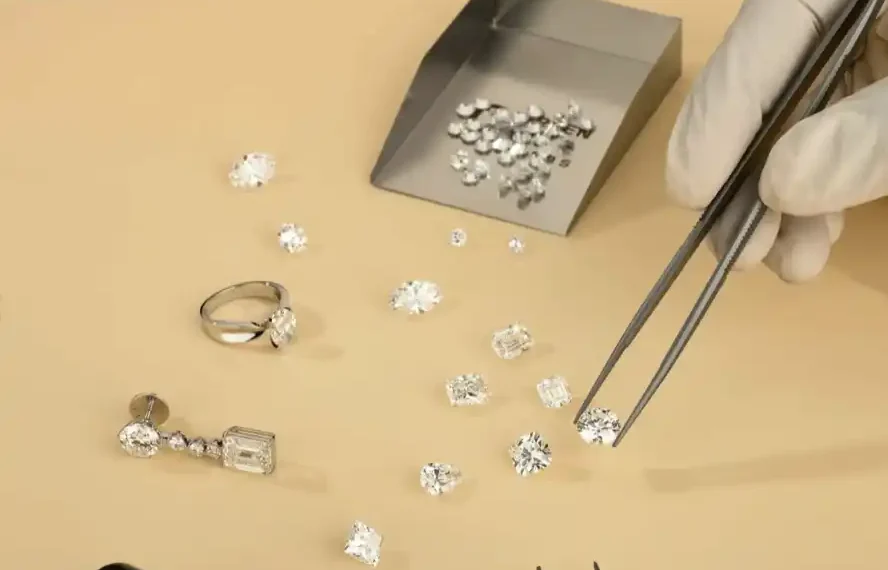
Lab-created diamonds, a modern marvel in the jewelry industry, are revolutionizing the way we perceive and acquire diamonds. In this article, we’ll delve into the fascinating world of lab-created diamonds, exploring their science, benefits, and impact on both consumers and the environment.
Introduction
What are lab-created diamonds?
Lab-created diamonds, also known as synthetic or cultured diamonds, are man-made gems with the same chemical composition, crystal structure, and optical properties as natural diamonds. The primary difference lies in their origin; while natural diamonds form deep within the Earth’s crust over millions of years, lab-created diamonds are produced in controlled laboratory settings in a matter of weeks.
The Science Behind Lab-Created Diamonds
How are lab-created diamonds made?
Lab-created diamonds are grown using two main methods: High Pressure High Temperature (HPHT) and Chemical Vapor Deposition (CVD). HPHT mimics the natural diamond formation process by subjecting a carbon source to high pressure and temperature, while CVD involves the deposition of carbon atoms onto a substrate in a vacuum chamber.
Advantages of lab-created diamonds in terms of purity and sustainability.
One of the key advantages of lab created diamonds are forever is their purity. Unlike natural diamonds, which may contain trace elements or inclusions, lab-created diamonds can be produced with exceptional clarity and consistency. Additionally, lab-created diamonds offer a more sustainable alternative to mined diamonds, as they require less energy and have a significantly lower environmental impact.
The Science Behind Lab-Created Diamonds (Continued)
Quality and Characteristics
Comparing quality factors with natural diamonds.
Lab-created diamonds are graded using the same criteria as natural diamonds, including the four Cs: carat weight, cut, color, and clarity. While natural diamonds vary in quality due to their geological formation process, lab-created diamonds can be engineered to meet specific quality standards, resulting in gems of exceptional brilliance and beauty.
Common misconceptions about lab-created diamonds.
Despite their growing popularity, lab-created diamonds still face misconceptions. Some believe that lab-created diamonds are inferior to natural diamonds or lack authenticity. However, lab-created diamonds are chemically identical to natural diamonds and offer the same brilliance and durability at a more affordable price point.
Environmental Impact
Sustainability benefits
Lab-created diamonds offer significant sustainability benefits compared to mined diamonds. By reducing the demand for diamond mining, lab-created diamonds help minimize habitat destruction, water pollution, and carbon emissions associated with traditional mining operations. Additionally, lab-created diamonds can be produced using renewable energy sources, further reducing their environmental footprint.
Reduction in environmental footprint compared to mined diamonds.
The environmental impact of diamond mining extends far beyond the physical extraction process. From land degradation and deforestation to the displacement of indigenous communities, the consequences of diamond mining are vast and long-lasting. Lab-created diamonds offer a more ethical and environmentally friendly alternative, ensuring that future generations can enjoy the beauty of diamonds without harming the planet.
Cost Comparison
Affordability compared to natural diamonds.
One of the most compelling advantages of lab-created diamonds is their affordability. On average, lab-created diamonds cost 20-40% less than natural diamonds of comparable quality. This price difference allows consumers to purchase larger or higher-quality diamonds within their budget, making lab-created diamonds an attractive option for engagement rings, fine jewelry, and other luxury items.
Factors influencing the price of lab-created diamonds.
While lab-created diamonds are generally more affordable than natural diamonds, their price can vary depending on several factors. These include the size, cut, color, lab diamonds, and clarity of the diamond, as well as market demand and production costs. By understanding these factors, consumers can make informed decisions when purchasing lab-created diamonds.
Ethical Considerations
Addressing concerns about conflict diamonds.
Conflict diamonds, also known as blood diamonds, are diamonds that are mined in war zones and sold to finance armed conflict and civil unrest. By opting for lab-created diamonds, consumers can ensure that their purchase does not contribute to human rights abuses or environmental destruction in conflict regions.
Ensuring ethical sourcing and production.
Many lab-created diamond manufacturers adhere to strict ethical and environmental standards throughout the production process. By choosing reputable brands and suppliers, consumers can support companies that prioritize transparency, sustainability, and ethical labor practices in the diamond industry.
Popularity and Trends
Increasing demand for lab-created diamonds.
In recent years, there has been a significant increase in demand for lab-created diamonds, driven by growing consumer awareness of their benefits and ethical considerations. Millennials and Gen Z, in particular, are increasingly choosing lab-created diamonds over mined diamonds, reflecting a broader shift towards sustainable and socially responsible consumption.
Fashion and consumer preferences.
Lab-created diamonds have also gained popularity among fashion-forward consumers and celebrities, who appreciate their versatility, brilliance, and eco-friendly appeal. From red carpet events to everyday wear, lab-created diamonds are making a splash in the world of fashion and luxury, proving that sustainability and style can go hand in hand.
Durability and Longevity
Properties that make lab-created diamonds durable.
Lab-created diamonds are renowned for their hardness and durability, scoring a perfect 10 on the Mohs scale of mineral hardness. This makes them suitable for everyday wear and ensures that they will retain their brilliance and beauty for generations to come. Additionally, lab-created diamonds are resistant to scratches, chips, and abrasions, making them ideal for engagement rings and other fine jewelry.


